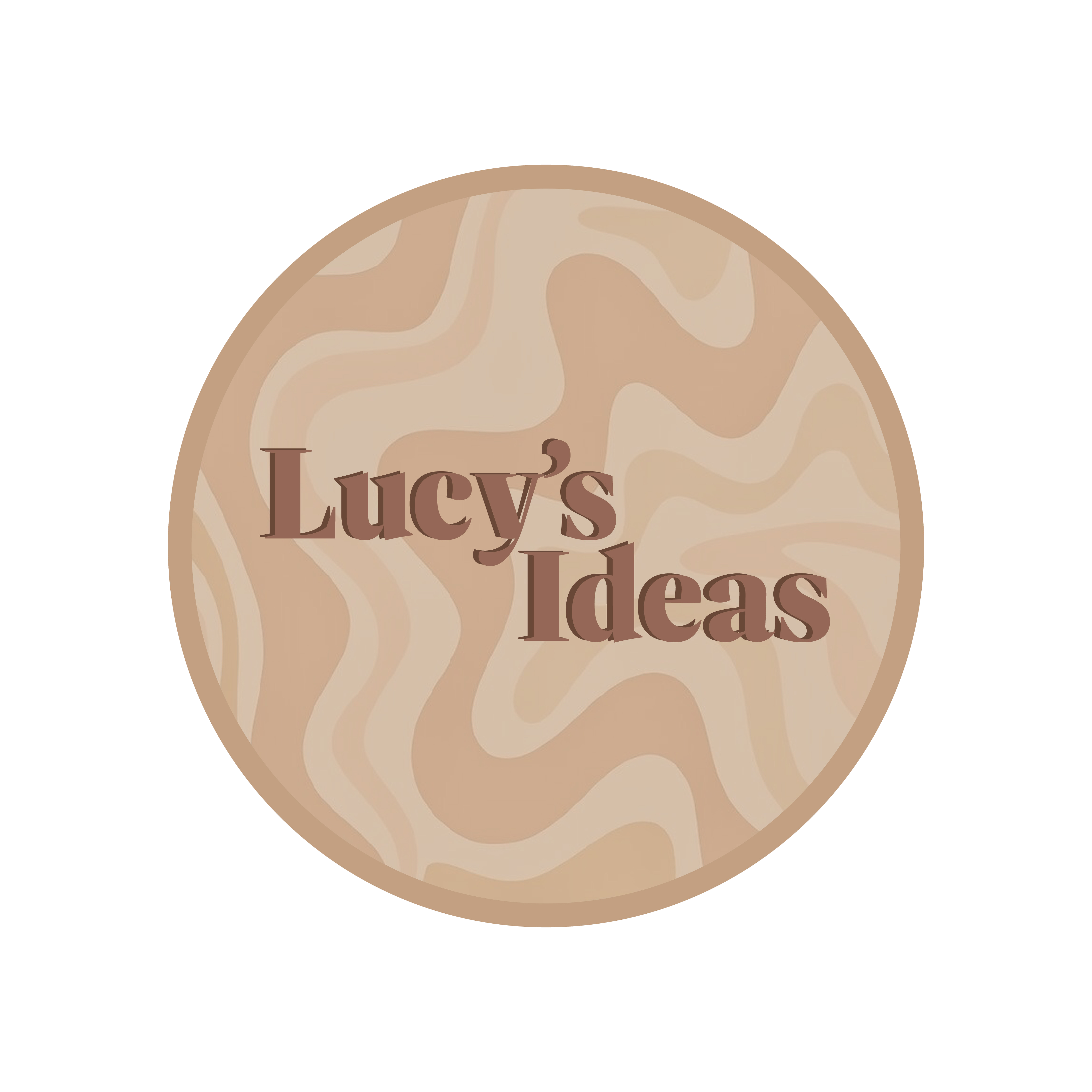Introduction
In today’s world, the most popular virtual reality experiences involve “taking total control of a user’s senses (sight and hearing, particularly) to create an immersive experience that places the user in a fully virtual environment.” (Marr, 2020). When considering my virtual reality botanical gardens experience, I will aim to produce an immersive scene allowing the user to escape reality and explore the 40 acres of relaxing space without having to leave the house. The intent of this niche project is to allow for students to use this up-and-coming technology as a getaway from academic stress to enhance the escape from the pressures of studying. The gardens will provide a calming and supportive environment to help young people engross in, emphasising the message of positive mental health during the increasingly stressful exam period. Throughout the production process, I aspire to demonstrate effective project management skills whilst incorporating forward-thinking through integrating emerging technology trends and concepts into my work. Further, I will apply my research-driven idea incorporating ethical values and principles throughout to ensure the user has the most positive experience as possible in VR.
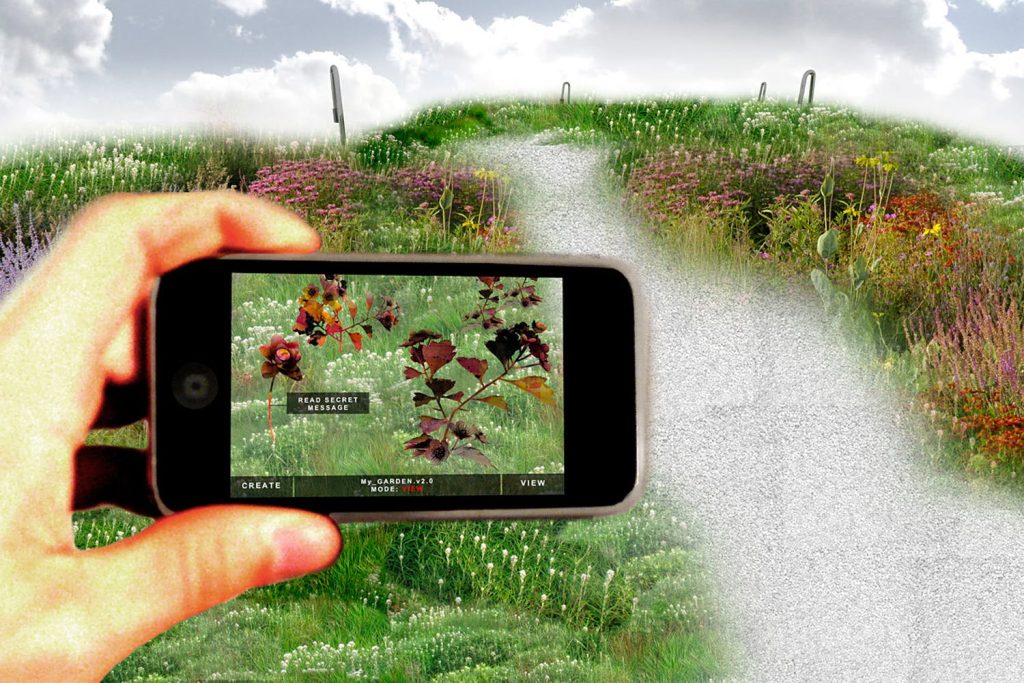
Idea Generation and Research
The initial research of the project was deciding what method of emerging technologies will be the most effective when producing an immersive project for a specific audience. From the beginning, I knew I favoured VR art due to my creative instincts and having the most experience using this software. I began to research what VR projects have become the most successful in recent times and thinking about how these can inspire my own creative ideas. There are a lot of generic thoughts that initially come to mind when thinking about VR such as producing escape rooms, famous artwork galleries, theme park rides, and more. I wanted to move away from the adventurous side of virtual reality and allow my audience to connect with the environment in a way that will calm them and allow peace into what can be assumed a very hectic schedule. “A beautiful virtual botanical garden makes for a relaxing space and ambitious artistic project. Create an escapist organic landscape where you can cultivate flowers, trees, and even add wildlife.” (Creative, 2018). This quote ultimately inspired me to go on to research how I can compose a meaningful, comforting experience that includes emerging technology trends and fully immerses the user.
When discussing what reasoning I wanted to put behind the idea of this project, I thought about why people interact with the virtual world in the first place – to escape reality. This thought stimulated looking at the healthcare sector and the reasons to the positive use of VR. “Research finds that therapy through VR headsets can achieve better mental health outcomes up to two to three times faster than traditional methods.” (openaccessgovernment.org, 2023). And with positive mental health being a key framework within schools and younger children, I wanted to create an experience that can become easily accessible, and which will help during stressful periods of education. An example of a successful VR application that is already providing help to numerous healthcare professionals is SyncVR, who curate VR experiences to “increase patient comfort, lower pain medication, enhance rehabilitation, and boost education through virtual experiences.” (syncvrmedical.com, 2023). Combining these thoughts together, I concluded on producing an accessible virtual experience that gives users (specifically young people in education) a chance to walk around a botanical garden to help ease and relax their thoughts from the ongoing academic stress they face. The final step was to find a reference point for the specific garden I want to create. Obviously, I needed to be able to access thorough images of the gardens for an accurate representation within the project. My local gardens are the University of Cambridge Botanical Gardens which adds further depth to the project linking back to the students at the university and using my content as an escape from their studies. Overall, I was able to use thorough research to inform and generate my final creative plans and aim to give my users a visually attractive and interactive experience.
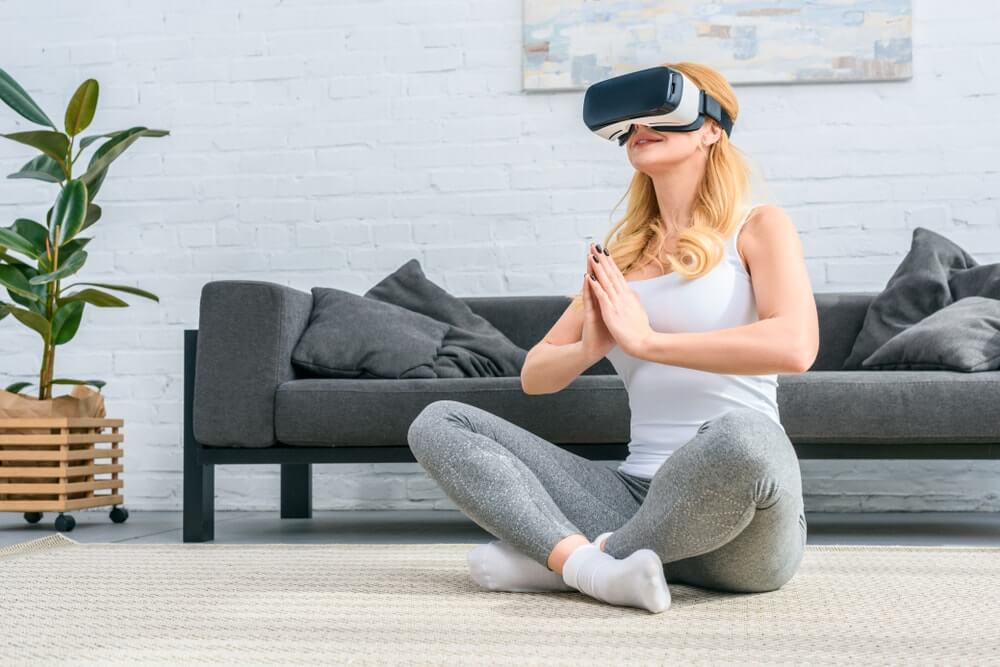
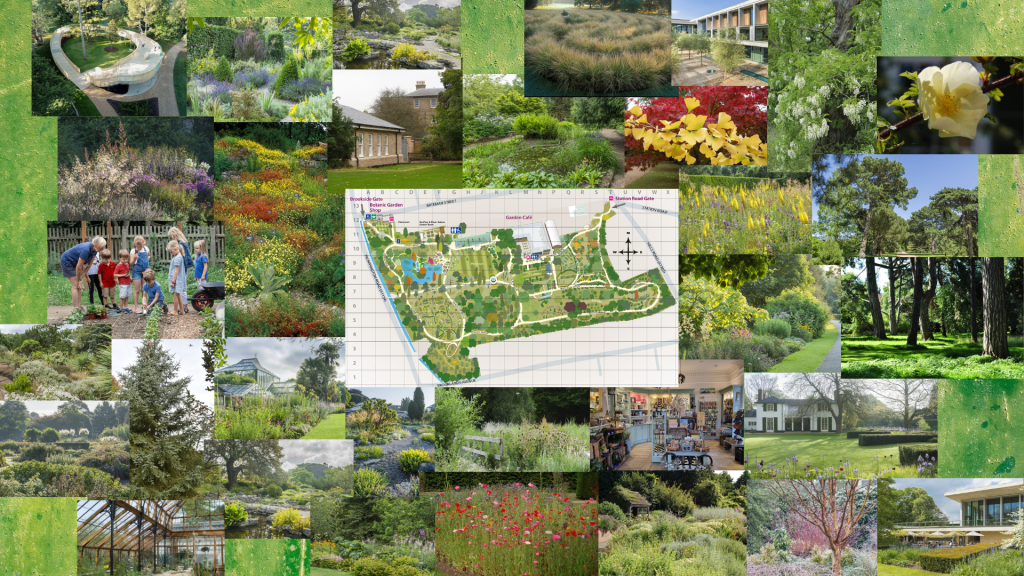
Project Management
I began with producing a coherent project plan in the form of a Gantt Chart to outline milestones throughout the project with anticipated timeframes and key deliverables. The reason I chose to use this method of planning was to ensure easier time management throughout and greater accountability so I can tell when a particular task was holding the project up. Gantt Charts help “manage milestones by displaying how much work is needed to complete each task and allow the project manager to review progress to determine if the project is on track.” (Team, 2022). I also produced user story’s at the initial stage of the research process so that I am constantly reminded of how the project will provide value to the audience. Below, you will find the initial Gantt Chart I created that conveys the progression throughout the project.

As with every creative design project, there were challenges we faced during the production process but also major successes that counter-balanced the overall time taken to complete. When referring to my initial research proposal, the key strategy I decided upon was producing story-sphere’s to allow sense to become of my initial blank starting scene. This further helped in the scaling process of my environment which was a challenge to begin with. In the Gravity Sketch software on the headset, I had to undertake a few tutorials based on the scale aspects of the software to ensure that the environment is ideal for my user and won’t cause any ethical issues with the spacing. This strategy further aided my creation of specific lighting of the scene which I encountered towards the end of the project. Due to efficient time management and the use of my Gantt Chart, I had completed the three-dimensional virtual world 3 days before schedule. This extra time was used to enhance the user testing period so that any issues with the immersive design can be dealt with so that my target audience can have the best experience possible.
One of the major influences that positively impacted the project was the use of prototyping/testing and Scrum user stories. “User Testing means you can target the real problem right away, so your team doesn’t spend time ‘fixing’ the wrong thing – so your time and money is invested in the right problem.” (Francis, n.d.). With no budget and a small-time frame, taking the essential time to usability test is vital for the management for the final design. Thinking about the design for immersion and accessibility, I began the testing process with a low-fidelity prototype that aims to captivate users, creating a realistic and consistent sense of interaction. Before giving my more-refined high-fidelity prototype to my users, I produced a paper sketch which you can see below that provides a basic outline of what the audience will see when within the environment. Seeing no issues with this, I moved onto the high-fidelity prototype that allowed users to wear the headset and complete a 5-minute tour of the immersive scene and provide follow-up answers to pre-prepared questions. Once the fellow students testing the prototype had completed the expedition, I asked questions that relate to my user stories and allow me to refine the project even further. Taking the negative feedback allowed me to perform more enhancements and produce a final immersive experience created with usability and virtual reality ethics at the forefront of the assembly.
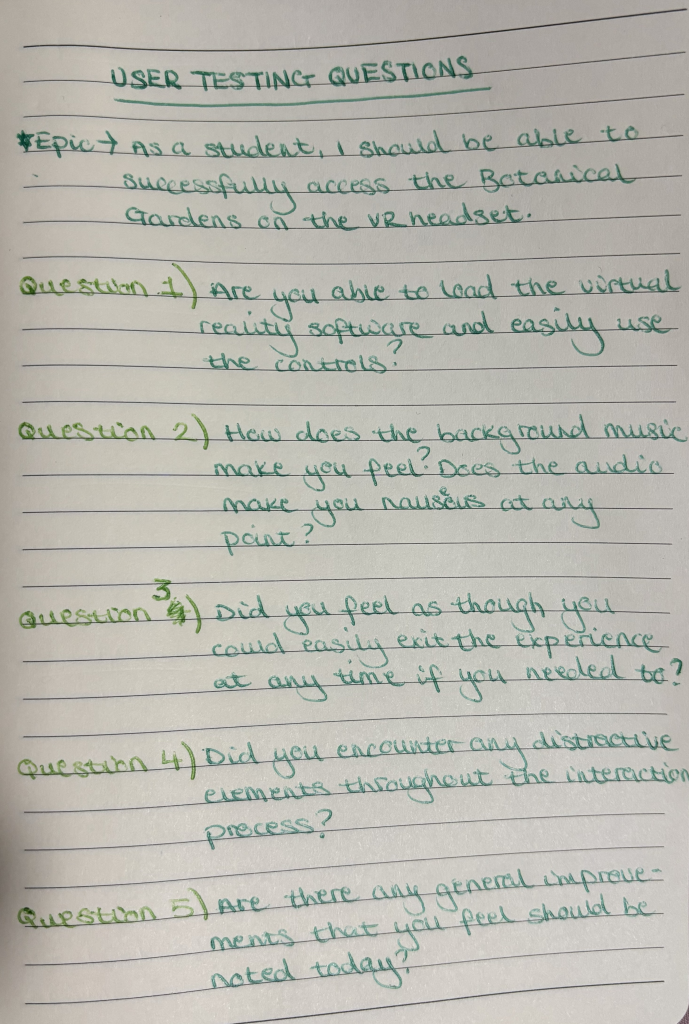
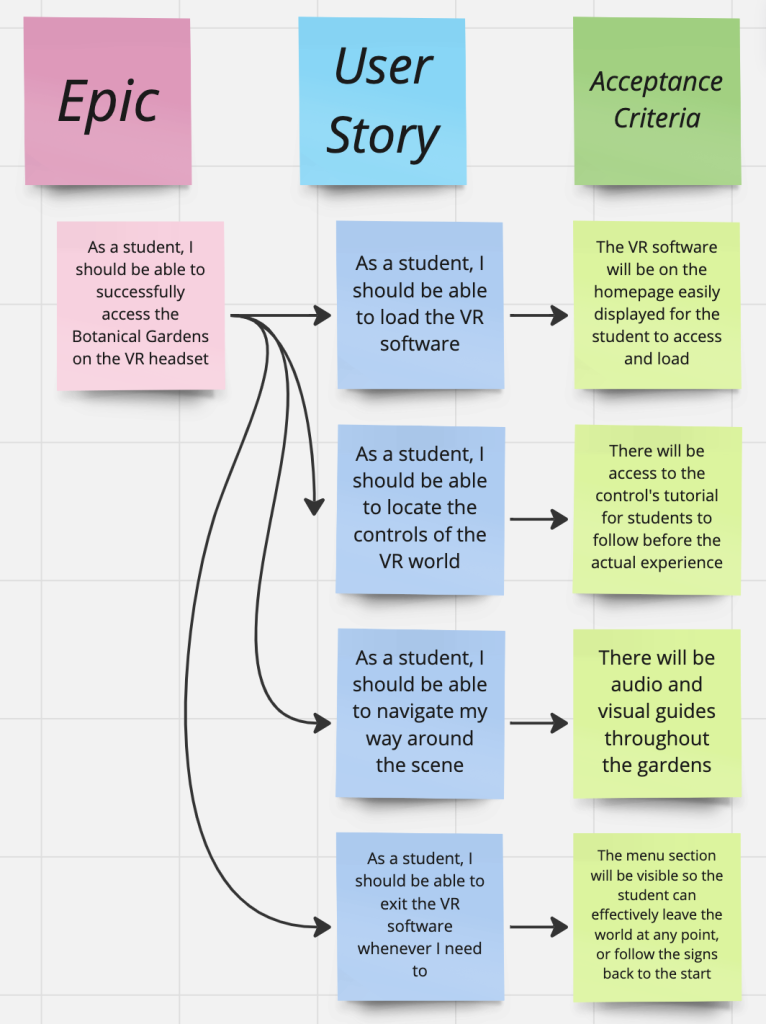
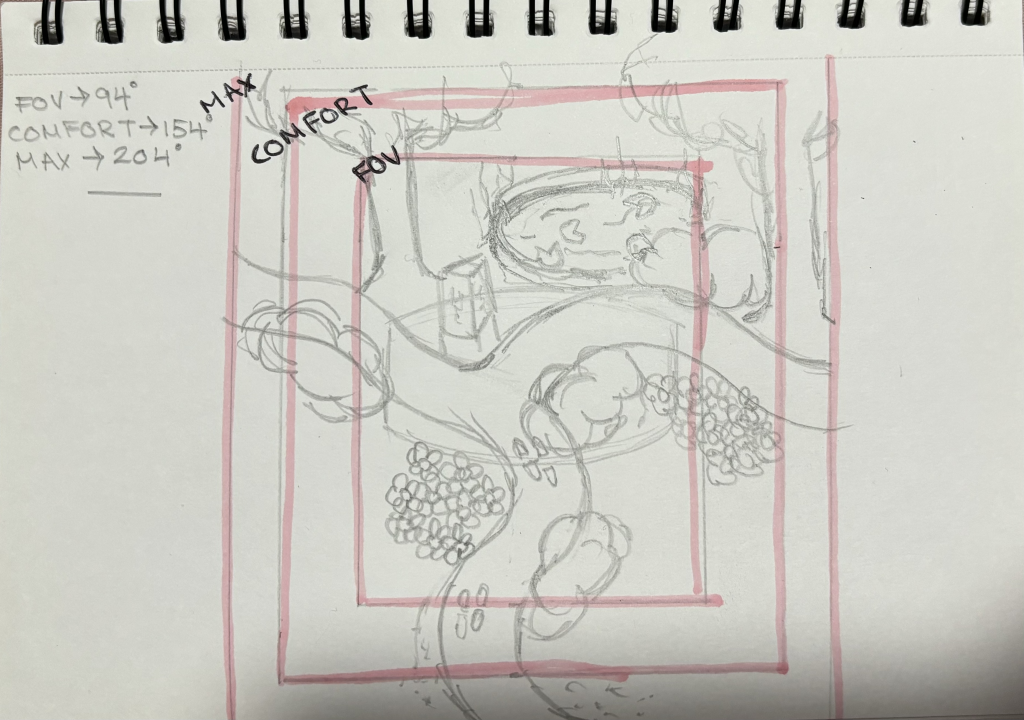
Software Proficiency
It is essential to use the right software that will enable me to use my time to an efficient standard when creating a large-scale project such as this one. When deciding to produce a virtual reality art experience for a student-user, it was clear that I needed to use specific equipment to allow for a successful completion. To help save time in the construction process, I used numerous high-quality free resources to guide me through the virtual reality project. (vrdirect.com, 2021). Once the planning stage was complete, I needed to narrow down what software tools I will use to benefit the outcome of the immersive environment. The initial landscape portrays a more abstract and hand-drawn effect by using Gravity Sketch to produce the base of the land and the sky scene throughout. Due to the ethical reasoning behind having limited sessions in the VR world, I thought it was more efficient to use the Gravity Sketch iPad tool to help produce the individual models that will create my botanical gardens. However, these models will be referenced with story-sphere’s within the headset to control scale and positioning. Using the different methods of the sketching app enhanced the quality of the models with more detailed versions being completed on the iPad to combine both technologies and ensure the vision I had at the beginning of the project is composed.
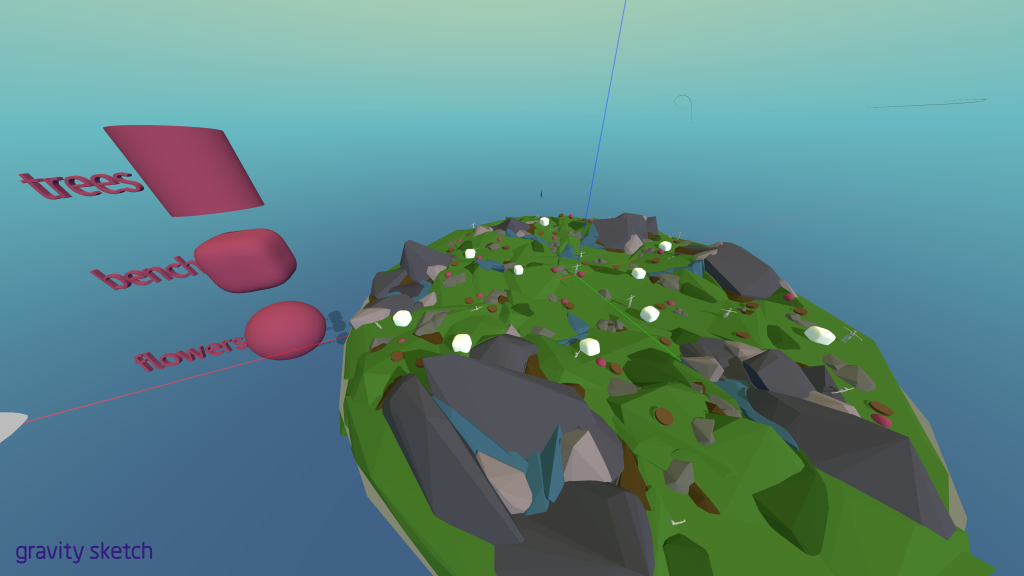
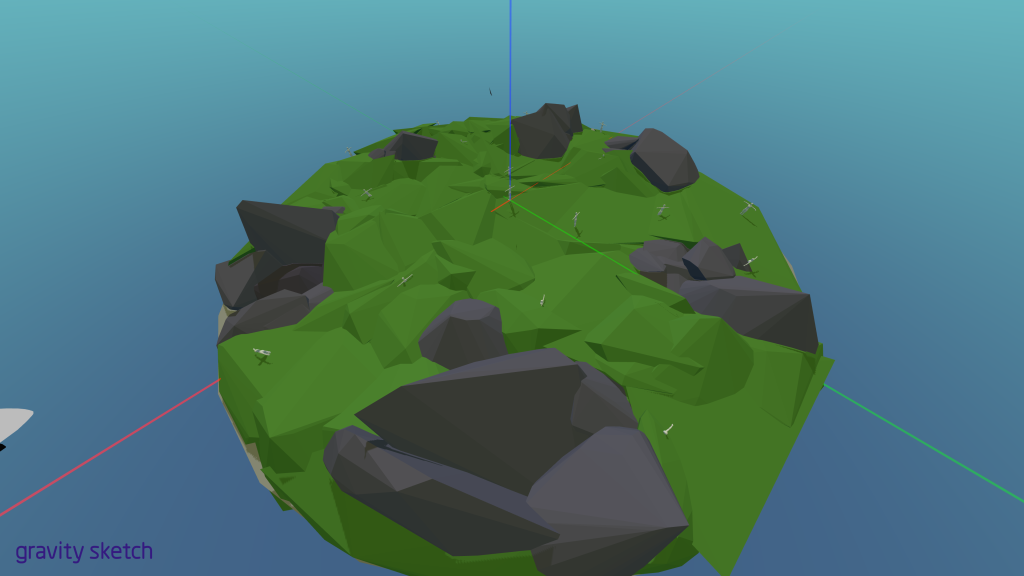
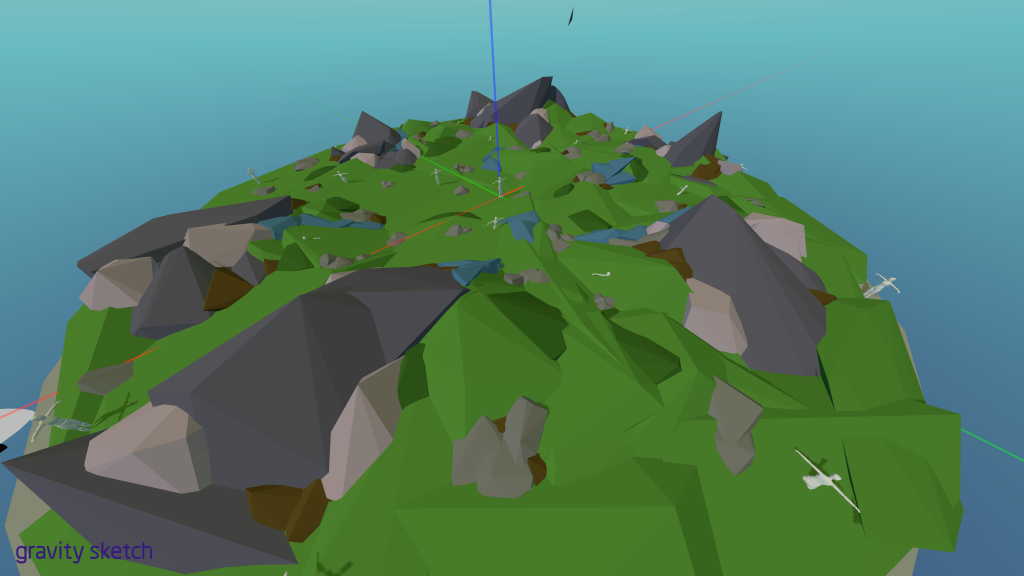
As previously mentioned, I had planned to create a small 3D asset library that will positively influence how realistic my scene will be. Gravity Sketch has an area in the landing pad specifically for imported assets and textures to reinforce the use of downloaded 3D models. You will be able to find a full accredited list in the reference section of all the items that I have included within my project. I used a website named Turbosquid (Shuttershock) that allowed me to collect and use free licensed models and take inspiration from the aesthetics when producing my own materials within the software. Using both approaches of the models and textures established the importance of a schedule as this part of the project took the most amount of time and I don’t believe I could’ve achieved a high-quality prototype without them. Having previous knowledge within the world of 3D and virtual reality has enabled me to use all the mentioned software tools to a well-informed standard and use leftover time reforming areas of the project that needed improvement. Immersive content aims to be as accessible as possible and therefore, allowing guides and free resources throughout the development has heavily enhanced the outcome for the users and my target audience.
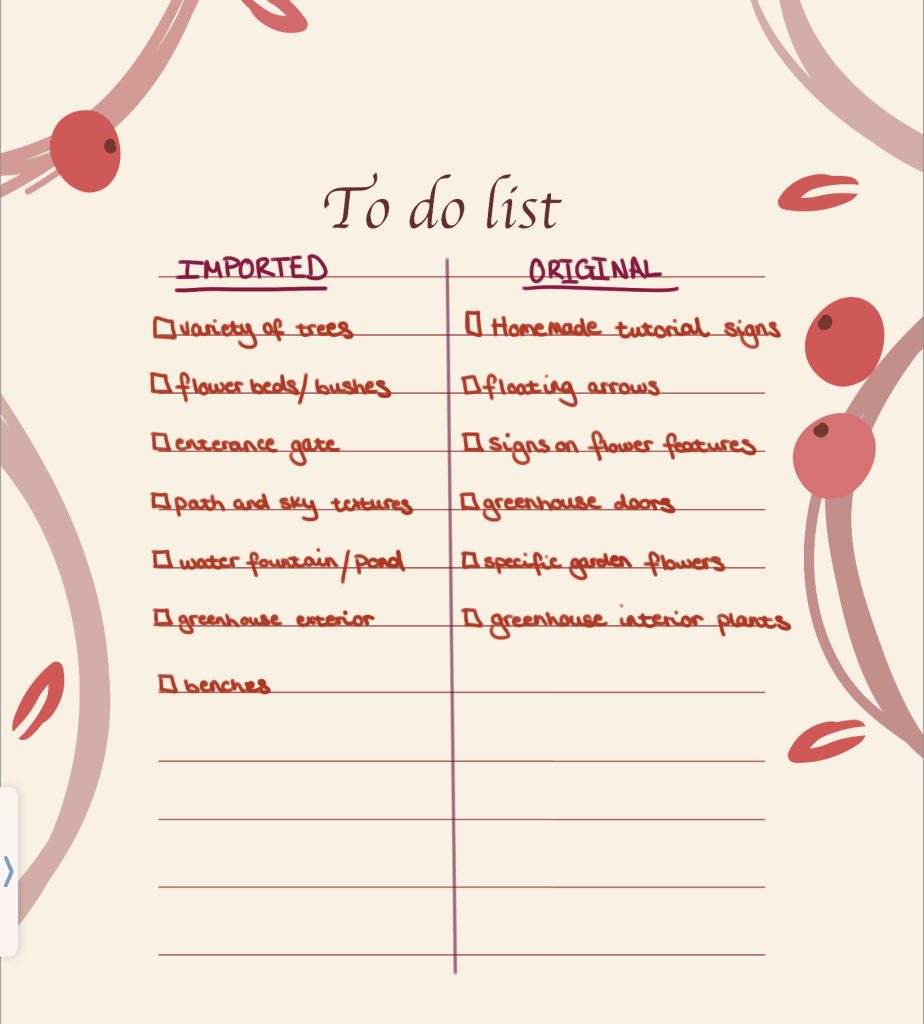
Ethics and Values
Virtual Reality has the possibility to change the way we live but can only be effective with the right support and vision. “This particular technology has the potential to transform society and improve our daily routines; overall improving the quality of life.” (Philips, 2022). Ethics are there to advise us on where the morally grey area is. They are essential when thinking about emerging technologies and how individuals rely on the extent to which the experience is perceived real. “It is reasonable to imagine that more realism in these VR scenarios increases their effectiveness.” (Slater, et al., 2020). With the rapid pace of change in immersive technology, as designers we need to rely on longstanding principles in the physical world and be aware of the important ethical questions that XR technology raises.
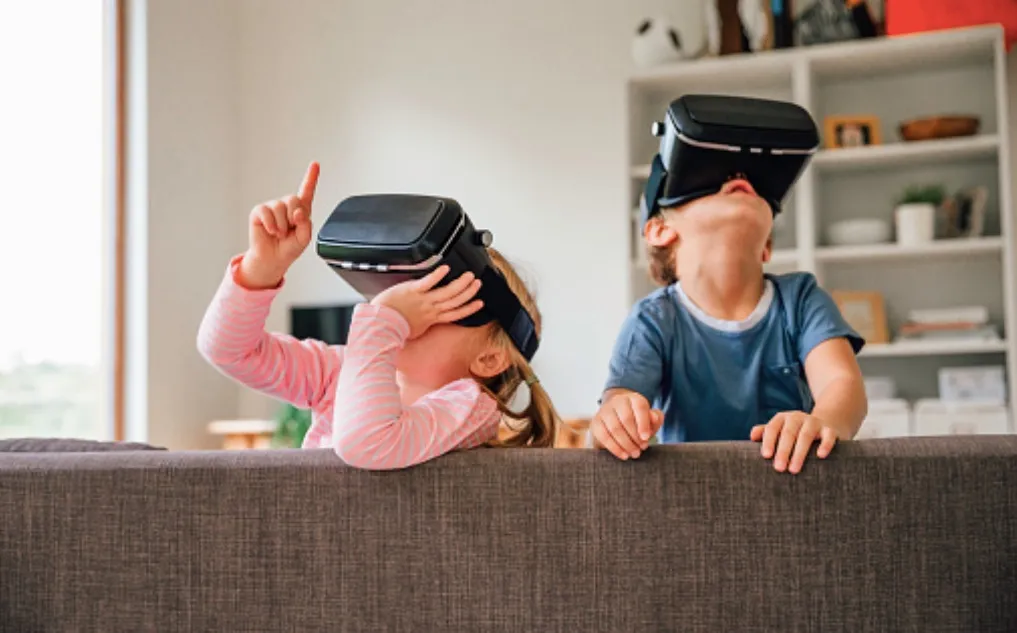
Virtual Reality can have a profound psychological impact including motion sickness and discomfort or altering perceptions of reality. I ensure to design content that considers the psychological well-being of the user and use the correct guidelines to minimise the negative effects felt. The use of calming sound features and guiding the user at a slow pace will manage the intensity of the experience. Furthermore, it is important to ensure that my VR experience is accessible to people with disabilities. As a designer, I aim to follow accessibility guidelines to accommodate for users with varying abilities. One important area I will be focusing on is regarding real world physics. “In regard to the speed or pace of your comfort settings, mirroring realistic physics will help minimise user discomfort.” (developer.oculus.com, 2023). My virtual environment of a quiet garden is very secluded and potentially isolating. Therefore, I want my design to strike a balance between virtual and real-world experiences to avoid the user spending excessive time in the experience.
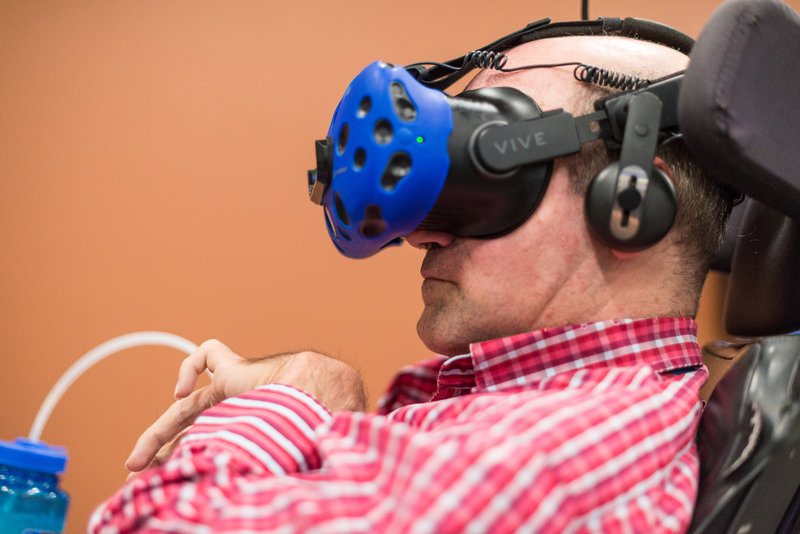
It is essential to include the correct spatial audio and background narration to steady the user in this new virtual world to ensure that they are not intimidated in any way. Going back to the free interactive resources previously mentioned, I used royalty free music to establish the best fitting, calming noise that will surround my user as they tour the botanical gardens. After numerous trial and error throughout user testing, we found that the track “Soft Vibes” adds a cosy, gaming like atmosphere as the user explores the different paths and plants throughout the environment. Alongside this, I used a royalty free footstep sound effect and incorporated that as spatial audio to fully immerse the audience when interacting and walking around the scene. The levels of the audio are thoroughly important so that the user doesn’t feel overwhelmed when entering the new reality and ensuring their senses remain calm.
Forward-Thinking and Emerging Trends
“One of the things that make VR devices so appealing is their potential for use in a variety of different settings.” (Kohen, 2023). Virtual reality is an ever-growing facet of technology that has extremely exciting potential in the future. It is often that we see VR headsets being used in the healthcare sector by health professionals treating and caring for their patients, enabling a simulation of life-like scenarios that supports complicated procedures. New research published by JMIR Mental Health states that “virtual reality can be useful in the treatment of anxiety and depression. Virtual Reality can be used effectively to augment and enhance traditional treatment methods, such as cognitive behavioural therapy.” (Marlynn Wei M.D., 2021). When relating back to the purpose of my botanical gardens virtual experience, it is clear that this content could be used in professional practices all over the world in helping treat anxiety-induced causes. This project may also expand to create botanical garden scenarios for locations around the world to enhance inclusivity and accessibility.

The term ‘immersive internet’ I feel refers to how emerging technologies will expand and flourish in the evolution of the online environment. The current trends within this topic explore “moving beyond flat web pages to create experiences that are more engaging, as well as conductive to shared interaction and collaboration.” (Marr, 2023). In my opinion, this starts with involving technologies such as AR and VR. For my specific topic of choice, I think combining AR and VR to provide a mixed reality experience would be even more powerful that having each on their own. “The convergence of immersive technology to create blended mixed-reality environments where the barriers between the real and the digital are blurred will become increasingly common.” (Marr, 2023). A user would be able to access the gardens through their VR headset in the comfort of their home while being able to collaborate with an online server to join people in real-time who are visiting the gardens. In the reality version, the people wearing AR glasses would be able to see the virtual attendees standing alongside them. There is potential for emerging technologies to enhance our everyday lives with numerous aspects of the ever-growing concepts of virtual reality.

References and Attribution
Royalty Free Music: Bensound.com
License code: C0F3LODQ7HUDSZJE
References
Asset, M., 2022. [Online]
Available at: https://www.turbosquid.com/3d-models/3d-model-bench01-1982255
[Accessed 27 January 2024].
brainvire.com, 2018. Reinventing the Concepts of Gardening with Augmented Reality. [Online]
Available at: https://www.brainvire.com/blog/reinventing-the-concepts-of-gardening-with-augmented-reality/
[Accessed 05 December 2023].
Creative, K., 2018. 7 Project Ideas For Creating Virtual Reality Environments. [Online]
Available at: https://blog.kadenze.com/creative-technology/7-project-ideas-for-creating-virtual-reality-environments/
[Accessed 07 December 2023].
developer.oculus.com, 2023. VR Accessibility Design: Locomotion. [Online]
Available at: https://developer.oculus.com/resources/design-accessible-vr-locomotion/
[Accessed 05 December 2023].
Francis, N., n.d. Every business should understand the importance of user testing. [Online]
Available at: https://marvelapp.com/blog/importance-user-testing/
[Accessed 23 January 2024].
iDiteMD, 2021. Cartoon Pond 3D. [Online]
Available at: https://www.turbosquid.com/3d-models/cartoon-pond-3d-1771135
[Accessed 27 January 2024].
India, S., 2018. Mixed Reality Technology – The Future of Virtual and Augmented Reality is Here. [Online]
Available at: https://www.spec-india.com/blog/mixed-reality-technology-the-future-of-virtual-and-augmented-reality-is-here
[Accessed 05 December 2023].
Kohen, N., 2023. Is Virtual Reality The Future?. [Online]
Available at: https://www.forbes.com/sites/forbestechcouncil/2023/02/10/is-virtual-reality-the-future/?sh=16abf33748ab
[Accessed 05 December 2023].
MarchCAT, 2018. 3D Fence. [Online]
Available at: https://www.turbosquid.com/3d-models/3d-fence-1301088
[Accessed 27 January 2024].
Marlynn Wei M.D., J., 2021. New Research Finds Virtual Reality Can Help Treat Anxiety. [Online]
Available at: https://www.psychologytoday.com/us/blog/urban-survival/202109/new-research-finds-virtual-reality-can-help-treat-anxiety#:~:text=New%20research%20published%20in%20JMIR%20Mental%20Health%20has,such%20as%20cognitive%20behavioral%20therapy%20and%20exposure%20
[Accessed 05 December 2023].
Marr, B., 2020. The Future Of Virtual Reality (VR). [Online]
Available at: https://www.forbes.com/sites/bernardmarr/2020/12/18/the-future-of-virtual-reality-vr/?sh=3fbeb33427be
[Accessed 05 December 2023].
Marr, B., 2023. The 10 Biggest AR, VR And Immersive Internet Trends In 2014. [Online]
Available at: https://www.forbes.com/sites/bernardmarr/2023/10/13/the-10-biggest-ar-vr-and-immersive-internet-trends-in-2024/?sh=58be413466de
[Accessed 05 December 2023].
Olmsted, J., 2021. Top Use-Cases Of Using VR In Healthcare. [Online]
Available at: https://www.healththoroughfare.com/disease-medicine/top-use-cases-of-using-vr-in-healthcare/35079
[Accessed 05 December 2023].
openaccessgovernment.org, 2023. Immersive VR headsets to improve mental health services. [Online]
Available at: https://www.openaccessgovernment.org/immersive-vr-headsets-improve-mental-health-services/160025/#:~:text=Research%20finds%20that%20therapy%20through%20VR%20headsets%20can,the%20severity%20of%20some%20mental%20health%20condition%20symptoms.
[Accessed 07 December 2023].
Philips, K., 2022. Augmented tech can change the way we live, but only with the right support and vision.. [Online]
Available at: https://www.weforum.org/agenda/2022/08/ethics-not-technological-limits-will-be-the-guiding-factor-for-an-augmented-age/
[Accessed 05 December 2023].
Slater, M. et al., 2020. The Ethics of Realism in Virtual and Augmented Reality. Virtual Real, 3 March.Volume 1.
Stockton, J., 2018. Walking With Reality. [Online]
Available at: https://www.unr.edu/nevada-today/nevada-stories/walking-with-reality
[Accessed 05 December 2023].
storycentral, 2017. The Ethics of VR: Inside a Child’s Virtual World – Part I. [Online]
Available at: https://medium.com/@storycentral/the-ethics-of-vr-inside-a-childs-virtual-world-f49493971d2c
[Accessed 05 December 2023].
Studio, W., 2021. 3D model Lowpoly Nature Pack. [Online]
Available at: https://www.turbosquid.com/3d-models/3d-model-lowpoly-nature-pack-1764322
[Accessed 27 January 2024].
syncvrmedical.com, 2023. Improve healthcare with Virtual Reality. [Online]
Available at: https://www.syncvrmedical.com/
[Accessed 07 December 2023].
Team, A. C., 2022. What is a Gantt Chart? benefits, how to use them, and more.. [Online]
Available at: https://business.adobe.com/blog/basics/what-is-a-gantt-chart
[Accessed 05 December 2023].
Velvet~beetle, 2023. Greenhouse in the garden. [Online]
Available at: https://sketchfab.com/3d-models/greenhouse-in-the-garden-955afc94f2134b5db39a515dcf3ce0a9
[Accessed 27 January 2024].
Ventores, 2022. Garden furniture 3D. [Online]
Available at: https://www.turbosquid.com/3d-models/garden-furniture-3d-1841667
[Accessed 27 January 2024].
vladhunter, 2020. 3D Fountain. [Online]
Available at: https://www.turbosquid.com/3d-models/3d-fountain-1503749
[Accessed 27 January 2024].
vrdirect.com, 2021. 20 Free Resources To Help You Create An Interactive VR Project. [Online]
Available at: https://www.vrdirect.com/blog/vrdirect-products-news/20-free-resources-to-help-you-create-an-interactive-vr-experience/
[Accessed 23 January 2024].
VR, S., 2016. Japanese Garden – VR experience. [Online]
Available at: https://www.youtube.com/watch?v=voGUSm47vhQ
[Accessed 07 December 2023].
Watson, T., 2020. Virtual Reality and Mental Health – Therapy & Treatment with VR Technology. [Online]
Available at: https://skywell.software/blog/virtual-reality-and-mental-health-therapy-treatment/
[Accessed 07 December 2023].
